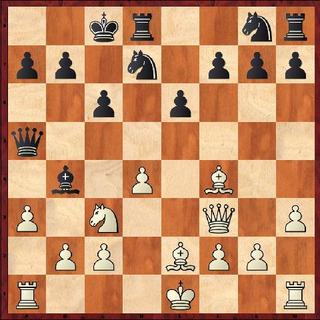White to Play
Published in Chess Puzzles

We’ve spent a good deal of time on middle game attacking positions and, recently, endgame positions. Now, we’re going to head into an area near and dear to all chess players—the opening. In my new book, Openings for Amateurs, I point out a lot of common mistakes the average club player makes in the openings. We’re going to expand on that in the coming weeks with mistakes that come from actual games.
This position arose from a game, Canal-Horvath, Budapest, 1934, and, after
1.e4 d5 2.exd5 Qxd5 3.Nc3 Qa5 4.d4 c6 5.Nf3 Bg4 Modern players of the Black pieces have pretty much given up on Bg4 moves in the Scandinavian, replacing it with Bf5.
6.Bf4 e6 7.h3 Bxf3 8.Qxf3 Bb4 Another aggressive looking bishop move that is not so hot. Better was Nf6. 9.Be2 Nd7 10.a3 0–0–0 This allows a quick win for White, but the alternatives were gloomy as well for Black. His earlier "slight errors" with bishop placement brought him here. Some other possibilities: 10...Ngf6 11.Rb1 Be7 12.b4 Qd8 13.b5 c5 14.d5 e5 15.Bg3 0–0 16.0–0; 10...Bxc3+ 11.bxc3 Qd5 12.0–0 Qxf3 13.Bxf3. How did Canal finish Horvath off here?
Solution:
Canal used the well-known two rook sacrifice offer, which Black cannot refuse expecting a different result: 11.axb4 Qxa1+ 12.Kd2 Qxh1 13.Qxc6+ Black Resigns because 13...bxc6 14.Ba6 mate! The Boden mate. We did this pattern some years back. Did any of you remember it?
Send questions and comments to PTamburro@aol.com.






